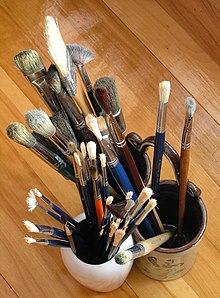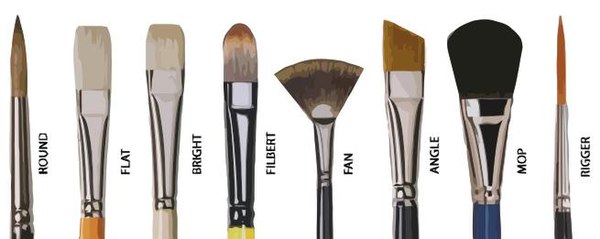Brush
This article needs additional citations for verification. (February 2007) |

The term brush refers to devices with bristles, wire or other filaments, used for cleaning, grooming hair, make up, painting, surface finishing and for many other purposes.
Configurations include twisted-in wire (e.g. bottle brushes), cylinders and disks (with bristles spread in one face or radially).
A common way of setting the bristle in the brush is the staple or anchor set brush, in which the filament is forced with a staple by the middle into a hole with a special driver and held there by the pressure against all of the walls of the hole and the portions of the staple nailed to the bottom of the hole. The staple can be replaced with a kind of anchor, which is a piece of rectangular profile wire that is anchored to the wall of the hole, like in most toothbrushes. Another way to attach the bristles to the surface can be found in the fused brush, in which instead of being inserted into a hole, a plastic fiber is welded to another plastic surface, giving the option to use different diameters of bristles in the same brush.
Manufacturing process of a brush handle
The first requirement when manufacturing a cleaning style brush is to start with the brush block. This can vary in wood type, the most commonly used handles comes from maple. Once the wood type is selected it is then cut into planks with in a certain width requirement. Throughout this process workers mark down where the cracks or knots are in the wood and draw a red line across the flaw with a special wax crayon. A laser can read this line as the planks are moved forward, cutting the line with a saw. Shortly after the blocks are cut to the appropriate length, moving on to the shaping of the block known as molding.
Once the wood block is set in place for molding, a series of saws cut the block to the required thickness. A machine called the shaper follows this action. The brush handle is placed in the machine, revolving and slicing away the outside edge. This only cuts away half of the block. To keep in good profile the same actions are done to the opposite side. Each model uses a different shaper machine. The machines must stay sharp for the blocks to remain smooth and accurate. Carbide cutters are used in these machines rather than steel because carbide is much harder and more durable.
Cleaning brushes
Brushes used for cleaning come in various sizes. They vary in size from a that of a toothbrush, to the standard household version accompanied by a dustpan, to 36" deck brushes. There are brushes for cleaning tiny cracks and crevices and brushes for cleaning enormous warehouse floors. Brushes perform a multitude of cleaning tasks. For example, brushes lightly dust the tiniest figurine, they help scrub stains out of clothing and shoes, they remove grime from tires, and they remove the dirt and debris found on floors with the help of a dust pan. Many kinds of specialty brushes are used for cleaning vegetables, cleaning the toilet, washing glass, finishing tiles, and sanding doors.
Paintbrushes
It has been suggested that this article should be split into a new article titled Paintbrushes. (discuss) (July 2009) |

Paintbrushes are used for applying ink or paint. These brushes are usually made by clamping the bristles to a handle with a ferrule.
Decorators' brushes
The sizes of brushes used for painting and decorating is given in mm or inches, referring to the width of the head.
Common sizes are:
- ⅛ in, ¼ in, ⅜ in, ½ in, ⅝ in, ¾ in, ⅞ in, 1 in, 1¼ in, 1½ in, 2 in, 2½ in, 3 in, 3½ in, 4 in.
- 10 mm, 20 mm, bob 40 mm, 50 mm, 60 mm, 70 mm, 80 mm, 90 mm, 100 mm.
Bristles may be natural or synthetic. If the filaments are synthetic, they could be made of polyester, nylon or a blend of nylon and polyester. Filaments can be hollow or solid and can be tapered or untapered. Brushes with tapered filaments give a smoother finish. [1]
Synthetic filaments last longer than natural bristles. Natural bristles are preferred for oil-based paints and varnishes, while synthetic brushes are better for water-based paints as the bristles do not expand when wetted. [2]
A decorator judges the quality of a brush based on several factors: filament retention, paint pickup, steadiness of paint release, brush marks, drag and precision painting. A chiseled brush permits the painter to cut into tighter corners and paint more precisely. [3]
Handles may be wood or plastic; ferrules are metal (usually nickel-plated steel).
Artists' brushes
Short handled brushes are for watercolor or ink painting while the long handled brushes are for oil or acrylic paint. The styles of brush tip seen most commonly are:
- Round: Long closely arranged bristles for detail
- Flat: For spreading paint quickly and evenly over a surface. They will have longer hairs than their Bright counterpart.
- Bright: Flat brushes with short stiff bristles, good for driving paint into the weave of a canvas in thinner paint applications, as well as thicker painting styles like impasto work.
- Filbert: Flat brushes with domed ends. They allow good coverage and the ability to perform some detail work.
- Fan: For blending broad areas of paint.
- Angle: Like the Filbert, these are versatile and can be applied in both general painting application as well as some detail work.
- Mop: A larger format brush with a rounded edge for broad soft paint application as well as for getting thinner glazes over existing drying layers of paint without damaging lower layers.
- Rigger: Round brushes with longish hairs, traditionally used for painting the rigging in pictures of ships. They are useful for fine lines and are versatile for both oils and watercolors.

Some other styles of brush include:
- Sumi: Similar in style to certain watercolor brushes,also with a generally thick wooden or bamboo handle and a broad soft hair brush that when wetted should form a fine tip. Also spelled Sumi-e.
- Hake: An Asian style of brush with a large broad wooden handle and an extremely fine soft hair used in counterpoint to traditional Sumi brushes for covering large areas. Often made of goat hair.
- Spotter: Round brushes with just a few short bristles. These brushes are commonly used in spotting photographic prints.
- Stencil: A round brush with a flat top used on stencils to ensure the bristled don't get underneath. Also used to create texture.
Artists' brushes are usually given numbered sizes, although there is no exact standard for their physical dimensions.
From smallest to largest, the sizes are:
- 10/0, 7/0 (also written 0000000), 6/0, 5/0, 4/0, 000, 00, 0, 1, 2, 3, 4, 5, 6, 7, 8, 9, 10, 11, 12, 13, 14, 16, 18, 20, 22, 24, 25, 26, 28, 30. Brushes as fine as 30/0 are manufactured by major companies, but are not a common size.
Sizes 000 to 20 are most common.
Artists' brushes are most commonly categorized by type and by shape.
Types include: watercolor brushes which are usually made of sable, synthetic sable or nylon; oil painting brushes which are usually made of sable or bristle; and acrylic brushes which are almost entirely nylon or synthetic. Turpentine or thinners used in oil painting can destroy some types of synthetic brushes. However, innovations in synthetic bristle technology have produced solvent resistant synthetic bristles suitable for use in all media. Natural hair, squirrel, badger or sable are used by watercolorists due to their superior ability to absorb and hold water.
Shapes include rounds (pointed), flats, brights (shorter than flats) and filbert. Other shapes include stipplers (short, stubby rounds), deer-foot stipplers, liners (elongated rounds), daggers, scripts (highly elongated rounds), egberts and fans.
Bristles may be natural — either soft hair or hog bristle — or synthetic.
- Soft hair brushes are made from Kolinsky sable or ox hair (sabeline); or more rarely, squirrel, pony, goat, mongoose or badger. Cheaper hair is sometimes called camel hair, although it does not come from camels.
- Hog bristle (often called China bristle or Chungking bristle) is stiffer and stronger than soft hair. It may be bleached or unbleached.
- Synthetic bristles are made of special multi-diameter extruded nylon filament, or Taklon, multi-diameter polyester. and are becoming ever more popular with the development of new water based paints.
Artists' brush handles are commonly wooden but can also be made of molded plastic. Many mass-produced handles are made of unfinished raw wood; better quality handles are of seasoned hardwood. The wood is sealed and lacquered to give the handle a high-gloss, waterproof finish that reduces soiling and swelling.
Metal ferrules may be of aluminum, nickel, copper, or nickel-plated steel. Quill ferrules are also found: these give a different "feel" to the brush.
